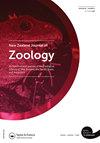白鼬对雄性人类气味的反应
IF 1.1
4区 生物学
Q3 ZOOLOGY
引用次数: 1
摘要
摘要白鼬在陷阱、诱饵和追踪隧道上发现并厌恶人类气味的风险是一个重要但尚未解决的问题。在这项试点研究中,观察了三只雌性和五只雄性圈养白鼬对三种实验气味的反应,其中两种是中性的,一种是潜在的显著气味,它们被引入了自己的笼子。向每只白鼬呈现一个随机序列的三种气味,这些气味擦在笼子里的塑料避难管上:(1)一个干净、清洗过的管子;(2) 山羊的气味,预计白鼬能察觉,但不会对它造成威胁;(3) 男性的体香(因为所有八只白鼬都习惯于由女性看护人喂养)。在所有试验中,我们观察到了气味标记行为,如管道嗅闻、肛门腺标记和身体摩擦。当治疗管被“雄性人类气味”摩擦时,白鼬的反应强烈且频繁,既有更强烈的肛门腺标记,也有增加头部摩擦行为,通常会产生痛苦反应。这些结果表明,可以进行广泛的实地试验,以检查这种反应是否表明野生白鼬对陷阱的反应。本文章由计算机程序翻译,如有差异,请以英文原文为准。
Reactions of stoats (Mustela erminea) to male human scent
ABSTRACT The risk that stoats can detect, and become averse to, human scent on traps, baits and tracking tunnels is an important but unsolved question. In this pilot study, the scent marking behaviour of three female and five male captive stoats was observed in response to three experimental scents, two neutral and one potentially significant, introduced into their home cages. Each stoat was presented with a random sequence of three scents rubbed onto a plastic refuge tube within the cage: (1) a clean, washed tube; (2) goat odour, expected to be perceptible by the stoat but not threatening to it; (3) the body scent of male humans (because all eight stoats were accustomed to being fed by a female human carer). We observed scent marking behaviours such as tube sniffing, anal gland marking and body rubbing during all trials. When the treatment tube was rubbed with ‘male human odour’, stoats reacted strongly and more often, both by more vigorous anal gland marking and also by adding head-rubbing behaviours which normally convey an agonistic response. These results suggest that an extensive field trial could be justified to check whether this response might indicate the reactions of wild stoats towards traps.
求助全文
通过发布文献求助,成功后即可免费获取论文全文。
去求助
来源期刊
CiteScore
2.80
自引率
0.00%
发文量
20
审稿时长
>12 weeks
期刊介绍:
Aims: The diversity of the fauna of the southern continents and oceans is of worldwide interest to researchers in universities, museums, and other centres. The New Zealand Journal of Zoology plays an important role in disseminating information on field-based, experimental, and theoretical research on the zoology of the region.

 求助内容:
求助内容: 应助结果提醒方式:
应助结果提醒方式:


